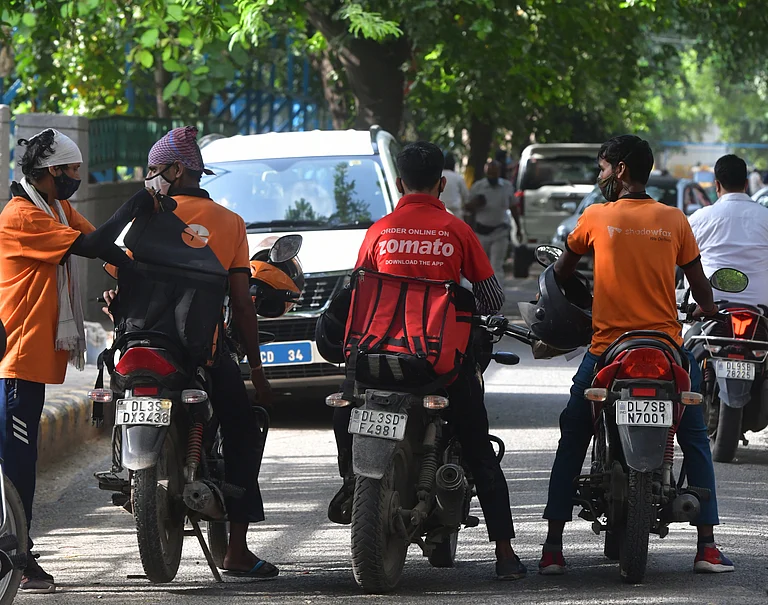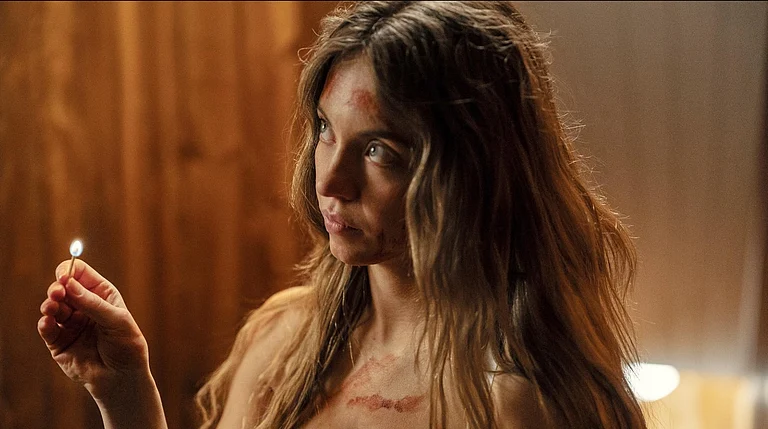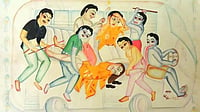On Friday, the public fountains at Student Park, Fatemi Square, and Artists' Park in Tehran, Iran’s capital city, turned bloody red. The identity of the artist or collective behind this is unknown, and Twitter users have titled these gurgling waters Tehran Covered In Blood.
This is the most recent form of protest art in solidarity with the 22-year-old Mahsa Amini, whose custodial death in Tehran after her arrest for not wearing her hijab according to the Islamic republic's conservative dress code, sparked massive anti-hijab protests. The outrage that is showing no signs of protest fatigue, is being fuelled by Iranian artists and illustrators through their paintings, slogans, posters, sculptures, performances, both offline and on social media platforms to voice their angst. Young girls and women have taken to painting Amini’s name on public walls, buildings and places.

While the red fountains, living sculptures, produced the illusion of blood, Zehra Doğan, the exiled Kurdish artist and journalist, on September 26, staged a protest performance, by smearing the railings outside the Iranian embassy in Berlin with a mixture of henna, hair and menstrual blood. Doğan, in a video posted on Twitter, is seen walking towards the embassy, hurriedly applying the mixture to the railings, and within minutes is accosted by two law enforcement officers. The tweet says: “Berlin, Iranian [Embassy]. We are in front of them with what they curse; menstrual blood, henna and hair. We are not alone, we’re everywhere!”
Lustrous hair, wild and free, for which Amini was accused of revealing more than instructed, has become the force of a performative exercise. Iranian women have waved and burned their veils, while women all over the world, have extended solidarity by posting videos of cutting their hair with a scissor.
An artist under the pseudonym smishdesigns posted an illustration of the collective female dissent on Instagram, and how doing so helped her in venting out anger. “Cutting off the hair goes against the decades/ worth of conditioning thrust upon women to maintain a certain beauty standard. I chose to capture that in my artwork hoping that women all across the world would relate to this powerful act of defiance against a heavily oppressive and patriarchal government,” she added.
Another artwork celebrating hair is the vibrant portrait of Amini in loud, bright pink, purple, red and yellow hues, by Bangladeshi visual artist, Adeena Hasan. In it, Amini is minus the hijab, her hair spread out as if caught by a gust of wind. A jasmine flower in her hair reminds that she did not “enrage anybody’s modesty” by revealing her hair and that the shackles behind her back celebrate the fact that her memory lives on. Hasan painted this work as she could not believe that “a girl had been beaten to death because her hairline showed a little too much for someone’s liking”, and also that “I could not fathom how suffocated and unheard she must have felt in her final hours.”
India and European countries like France, however, continue to witness pro-hijab protests, and contrary to the Western rhetoric of being viewed as oppressed, consider it as a symbol of pride and respect, and the women are fighting to assert their right of freedom of expression.
When Nicolas Sarkozy's government banned the niqab from public spaces, a 20-something burqa-clad French Muslim woman under the moniker Princess Hijab would strike at night, slapping black Muslim veils on the half-naked models in the Paris metro’s fashion adverts, and would call the act “hijabisation”. Her identity still remains unknown.
At home, Shilo Shiv Suleman, Bengaluru-based artist and founder of the public art project, Fearless Collective, protested the Bulli Bai app and hijab ban in Karnataka last year through Fearless posters, and some of these even became NFTs (Non-Fungible Tokens). This was part of the collective’s Haq movement, where, Muslim hijabi women were asked to send in their portraits that artists made into beautiful illustrations to celebrate diversity.
Iranian photojournalist Newsha Tavakolian recently resurrected on Instagram a photograph When I Was Twenty Years Old from her 2010-11 Listen series, in which the angst of the anti-hijab rioters is palpable through the subject, a young woman, standing in a deserted Tehran street, in black hijab and clothes, wearing a cherry red set of boxing gloves, staring at you. This and other photographs from the series for this 2015 recipient of the Prince Claus Award, is her own testimony to the obstacles she faced while photographing in public in Iran.

The hijab, thus, becomes an object representing the right to freedom, and also represents one’s right to practice their religion, minus stereotypes. Calgary-based artist Sumaya Bernier, growing up in the West, always felt her religion and culture were inaccurately represented in Western media. “We see a lot of the terrorist trope and the Muslim girl who needs saving, and all those movies where she removes her hijab for a love interest, which is awful and a really negative representation of Islam,” she was quoted saying. And so, Bernier created artworks that posited her Islamic identity in Canada, where she lives, where over the last two years crimes against Muslims have increased, and so she did it to “show the truth and the beauty of the religion.” Her painting of the Kaaba in Mecca with the sky from Vincent van Gogh’s Starry Night as the backdrop, and burqa-clad women among the devotees, is a case in point.
There are stray moments in contemporary history when the public celebrates Muslim identity, like that of Sally Almaklani, a freshman at Renaissance High School for Musical Theatre & the Arts, this year, who won the annual Congressional Art Competition and has had her artwork portraying a hijab-clad woman put on display at the US Capitol building. It has the message "my hijab makes me powerful" written on top in Arabic. Detractors might view the whole event as tokenism, but it's one step for the pro-hijab movement, albeit two steps backward for the anti-hijab one.


























